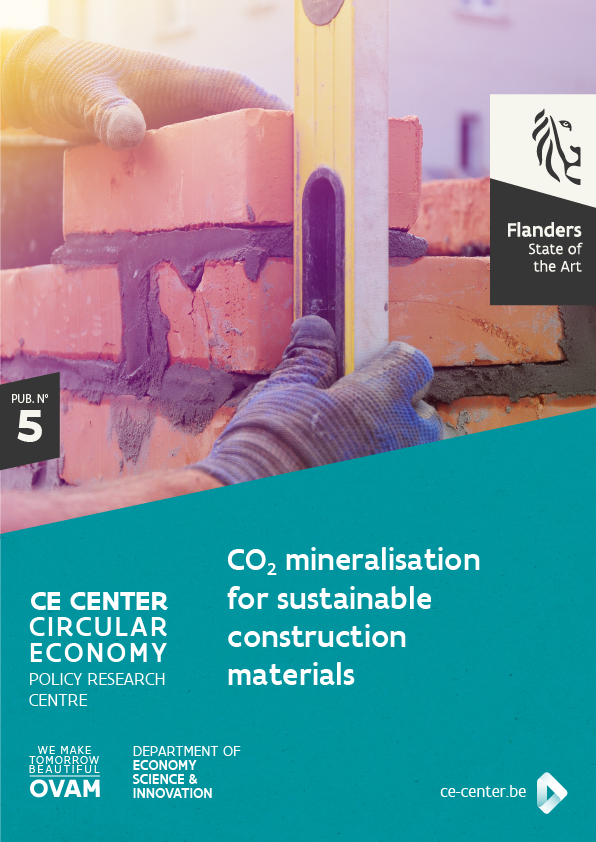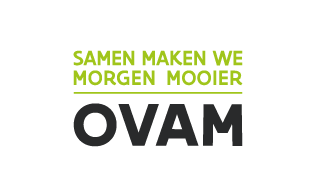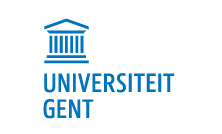5. CO2 mineralisation for sustainable construction materials
CO2 mineralisation for sustainable construction materials
Andrea Di Maria (Summa), Ruben Snellings (VITO), Luc Alaerts (Summa), Mieke Quaghebeur (VITO), Luc Alaerts (Karel Van Acker)
April 2019
 The production of Portland cement (PC) is today responsible for 8-10% of the global anthropogenic CO2 emissions. PC and PC-based blends are by far the most commonly used binder in concrete production, used in more than 99% of concrete applications. In such concrete, PC is accountable for 74-81% of the CO2 footprint. Therefore, substantial climate impact reductions for concrete will require eco-innovation at the cement level. Today, many new technologies are being developed to lower the CO2 emissions from cement and concrete industries. One of the most promising technologies is based on the partial substitution of traditional PC with industrial byproducts displaying cementitious properties, such as blast furnace slag form iron production, or coal combustion fly ashes from power generation. As byproducts, however, their availability and properties are rather constrained. For instance the shutdown of coal-fired electricity production already led to shortages in fly ash, or the increasing recycling of steel will lead to lower production of pig iron and less blast furnace slag. Therefore, future sustainable cements must rely on a wider variety of solutions. A diversification of local (secondary) raw materials to extend partial substitution of PC is ongoing, and new so-called “alternative binders” are taking their first steps into the market.
The production of Portland cement (PC) is today responsible for 8-10% of the global anthropogenic CO2 emissions. PC and PC-based blends are by far the most commonly used binder in concrete production, used in more than 99% of concrete applications. In such concrete, PC is accountable for 74-81% of the CO2 footprint. Therefore, substantial climate impact reductions for concrete will require eco-innovation at the cement level. Today, many new technologies are being developed to lower the CO2 emissions from cement and concrete industries. One of the most promising technologies is based on the partial substitution of traditional PC with industrial byproducts displaying cementitious properties, such as blast furnace slag form iron production, or coal combustion fly ashes from power generation. As byproducts, however, their availability and properties are rather constrained. For instance the shutdown of coal-fired electricity production already led to shortages in fly ash, or the increasing recycling of steel will lead to lower production of pig iron and less blast furnace slag. Therefore, future sustainable cements must rely on a wider variety of solutions. A diversification of local (secondary) raw materials to extend partial substitution of PC is ongoing, and new so-called “alternative binders” are taking their first steps into the market.
In the future, the construction materials sector will have to be more diverse and more sustainable, and at the same time safe and performant, meeting ambitious environmental and technical standards. Moreover, the production of new construction materials should be tailored to local resources, depending on the kind and availability of secondary raw materials from different industrial plants. In this context, the Intergovernamental Panel on Climate Change considers mineral carbonation as an important option to both mitigate atmospheric greenhouse gas concentrations and to produce sustainable concrete. Among others, a suitable class of materials for carbonation are alkaline slags generated as byproducts from steel production industry. For instance, stainless steel slags (SSS) are a byproduct generated during stainless steel production.
This study analyses the environmental performances of three examples of SSS mineralisation-curing, each using a different source of CO2:
- flue gas from steel industry, in which CO2 is separated through cryogenic process
- biogas from anaerobic digestion, in which CO2 is separated through membranes
- waste gas from ammonia production, in which CO2 is separated through chemical absorption
The CO2 recovered from the above mentioned sources is used to produce SSS-based construction blocks that are bound by CO2 as solid, stable carbonates, and that are equivalent in performance to precast non-reinforced concrete products on the market such as bricks or pavers.
Through an environmental evaluation based on life cycle assessment, the study highlights the environmental hotspots of the new proposed technologies. Taking into account only the production processes, all the three cases present lower total CO2-equivalent emissions compared to the paver PC-concrete, reducing the total CO2-equivalent emissions by 71% in the case of cryogenic separation, by 79% in the case of membrane separation, and 77% in the case of chemical absorption. Beside the reduction of the total CO2-equivalent emissions during the production, the carbonated blocks present also the advantage to serve as CO2 uptake and storage material, The final CO2-equivalent balance (difference between the CO2-equivalent emitted minus the uptake) is negative for all the analysed technologies (-5.4 kg for cryogenic, -6.8 kg for membrane separation and -6.5 kg for chemical absorption).
Therefore, the environmental results show the potential for the carbonation process to reduce the climate change impact of construction blocks production.
The second part of the study identifies the main environmental, economic and social elements playing a role in the development of the SSS-based carbonated blocks. Some of the main conclusions are listed below:
- Development of a CO2 valorisation network, both concerning the legal framework and infrastructures
- Need to exploit the economic potential of a CO2 recovery system
- Need to improve the regional CO2 balances, by taking into consideration also the effects of inter-regional trade
- Need of a successful certification system, to improve the negative perception of waste-derived materials among consumers
The aim is to provide useful elements in preparing the way for future policy advice, towards the reduction of the CO2 emissions from the cement and concrete industries and towards the high-quality valorisation of industrial residues.

.png)






